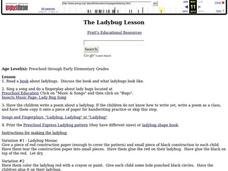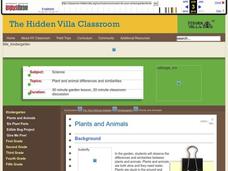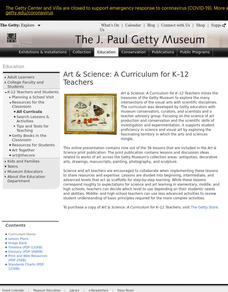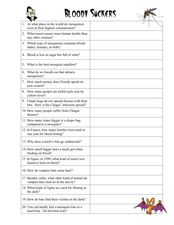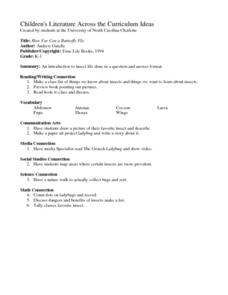Curated OER
The Very Hungry Caterpillar
A good book deserves to be followed up by a good worksheet. Here is a great resource which is intended for use after reading The Very Hungry Caterpillar by Eric Carle. It includes several activity ideas that promote skill development in...
Florida Center for Instructional Technology
Integrating Mathematics into Literature
You class will read Cucumber Soup by Vickie Leigh Krudwig as an anticipatory set for this instructional activity on ratios. They make models of the insects in the story and then use them as a source of data for this ratio and proportion...
Curated OER
Over in the Meadow
Students discover how to locate books on meadow and pond animals and research them. Students discover how to locate fiction/story books about the animals mentioned in the counting book read. Students discover how to locate by author,...
Curated OER
Arthropod Mouth Parts and Food
Students identify the different types of mouths arthropods have for eating various types of food. Given photographs of the different types of arthropods, students identify which mouth they have and what type of food they can eat with...
Curated OER
The Ladybug Lesson
Students explore the traits of ladybugs. In this ladybug lesson, students read books, sing songs, and learn fingerplays about ladybugs. Students also create their own ladybugs.
Curated OER
Larva and Adult Antlion Body Parts
Students identify the major body segments of antlions. Through the use of diagram worksheets, students label the various body parts of the antlion. They review the life cycle of antlions from the larva stage to adult. Several activities...
Curated OER
Insects: Grasshoppers
Students examine grasshoppers as they practice following instructions. In this biology lesson plan, students identify the characteristics of grasshoppers and the functions of grasshoppers' external body parts.
Curated OER
Going Buggy!
Students study bugs over a four week period. In this insect collection of activities, students observe insects covering basic science concepts and skills, such as classification, observation, and responses to habitat. Students develop...
Curated OER
Think Safe! Be Safe!
Students predict, observe, and explain how pillbugs, grasshoppers, stink bugs, and humans stay safe and protect themselves.
Curated OER
Meadow Study
Students examine insects they collect in a sweep nets. They identify as many of the insects as they can.
Cornell University
Field Day: Be an IPM Detective
Become a pest detective! Individually or in small groups, scholars scout the land to discover which pests—plant and animal—inhabit it, determine whether the pests are endangering the environment, and summarize their findings.
Cornell University
Weed IPM
Go on a weed hunt! Scholars gain insight into the characteristics of plants and examine the outdoor environment in order to identify five different types of weeds. Learners then show what they know with a one-page reflection.
Curated OER
Plants and Animals
Students taste test the garden. In this Science lesson, students compare and contrast plants and animals needs. Students pick fruits and vegetables in the garden and discuss their observations.
Curated OER
Crazy Critters
Eighth graders visit a local park to collect insects. They record the habitats, identify the insect and write a report including the kingdom, phylum, class, and order.
Curated OER
Grasshopper Plague
Students study grasshoppers and Mormon crickets by visiting website to view images and listen to sound. They research the issue of serious insect infestation. They read about students who eat the insects as snacks and read insect recipes.
Curated OER
Meadows Observations
Students investigate and examine the different living things they find in a meadow. Students record the different colors that are present and create a graph, identify and label parts of a plant, use a magnifying lens to examine all ...
Curated OER
Clearly Classified
Young scholars review the classification system for living organisms and apply it the classification of insects and flowers in the still life by Ambrosius Bosschaert. They create a chart classifying the animals and plants in the painting...
Curated OER
Bloody Suckers
In this blood sucking animals worksheet, students answer 20 questions about leeches, mosquitoes, Chepo bugs, and bats which all suck blood to transmit diseases or get nutrients.
Curated OER
A Remainder of One: A Math-Manipulative Lesson
Students listen to the reading of the book "A Remainder of One" and use math manipulatives to recreat "bug squadrons".
Curated OER
Camping/Catching Fireflies
Students create glow in the dark simulated lightning bug jars after reading stories about fireflies.
Curated OER
How Far Can a Butterfly Fly
Students draw a picture of their favorite insect and describe. Students make a paper art project ladybug and write a story about it. Students map areas where certain insects are more prevalent. Students count dots on ladybugs and record.
Curated OER
Bug Worksheet - Practice Counting
In this picture addition learning exercise, 1st graders count the number of butterflies. Students then circle or color the corresponding number.
Curated OER
Bug Worksheet - Practice counting
In this counting practice worksheet, 1st graders count the number of bees and circle or color the correct number that corresponds to the sum.
Curated OER
Bug Worksheet - Practice Counting
For this picture addition worksheet, 1st graders count the number of ladybugs. Students then circle or color the corresponding number.
Other popular searches
- Insects and Bugs
- Bugs and Insects Crafts
- Bugs and Insects Art
- Insects and Bugs Stencils
- Theme Insects and Bugs
- Bugs and Insects Prue School
- Studying Bugs and Insects
- Bugs and Insects Pre School
- Bugs and Insects Worksheet
- Bugs or Insects Anatomy
- Insects, Lightning Bugs
- Bugs Insects Free






